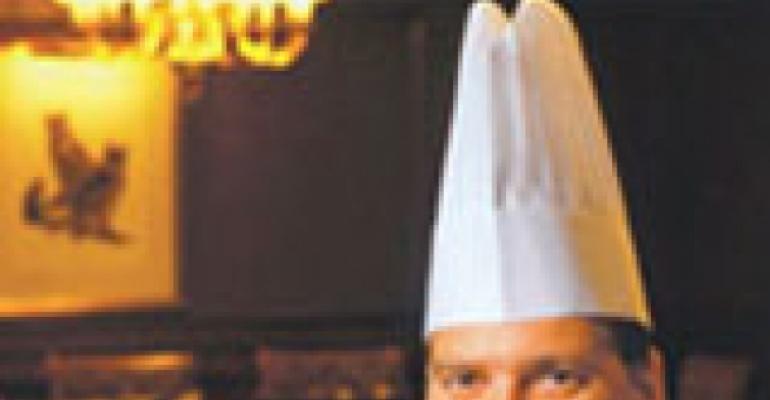As he assembled a slow-cooked roulade of chicken breast with mushroom stuffing on blanched, breaded and fried savoy cabbage along with other vegetables, Martin Heuser had no idea what international impressions he would make.
His assignment was to do something appetizing with chicken for Mexican President Vicente Fox, who was visiting Calgary, Alberta, in early 2005. Heuser was executive chef at the Westin Hotel there. Not only did President Fox call Heuser to the table to pay compliments, but also his wife later expressed awe to Heuser at how rare it was for her husband to eat vegetables. Canadian government officials followed up with a thank-you note asking Heuser for his recipe, which they forwarded to Fox.
Heuser is the protégé of a long line of German chefs who, for nearly 200 years, have run the family restaurant, Im Steinhaus, in Bonn, Germany, where Heuser was born and raised. Once he showed interest in cooking, his parents prepared to send him off to Steigenberger Hotel Management School at age 18. He later completed chef training at the Hotel Bristol in Bonn and earned his master chef’s diploma.
Heuser made the jump to North America in 1994 when he became a chef at a popular French restaurant in Vancouver, British Columbia. He shortly joined the Starwood chain of more than 900 hotels and worked at properties in Vancouver, Whistler and Calgary.
He craved change and a larger property, so in 2007 he moved over to Starwood’s sixth-largest North American property: The Westin Crown Center in Kansas City, Mo. As executive chef, he oversees all of the hotel’s food outlets, including banquet operations, Benton’s Steak and Chop House, and The Brasserie.
Coming from outside the Midwest, how do you view the Kansas City food scene?
BIOGRAPHY
Title: executive chef, the Westin Crown Center Hotel, Kansas City, Mo.—overseeing Benton’s Steak and Chop House and The BrasserieBirth date: Nov. 30, 1964Birthplace: Bonn, GermanyEducation: Steigenberger Hotel Management School, Bad Reichenhall, Germany, with chef training at the Hotel Bristol, Bonn, GermanyCareer highlights: preparing dinner separately for Mexican President Vicente Fox and Queen Elizabeth in 1995 and for Luciano Pavarotti in 1996; in 2005 being named Chef of the Year by the Calgary Academy of Cooks and Chefs; winning 2005 Calgary Iron Chef
I think Kansas City is hiding behind potential. There are a few outstanding restaurants, but Kansas City is a little behind the big cities in uniqueness and celebrity chefs.
Generally, the Kansas City palate leans toward steak and potatoes—and barbecue. Do you find that to be a challenge?
That is the case, and I find it runs through the suppliers. If I need specialty produce, I have to request it two weeks early to make sure they can get it here on time. I like to bring in peppadew or dragon fruit. I also do a lot of roots like salsify and celery root, a lot of unique products that aren’t that common on other menus here. Since there’s no demand for it in this market, the suppliers don’t automatically bring it in.
How are you able to interest guests in the more unique things on your menu at Benton’s, such as sous-vide rabbit risotto, duck-fat-confit wild salmon and shabu-shabu?
Often, when I’m trying to show something new or different, I put it on the appetizer menu so they can experience it without having to make a commitment for a lot of money for something they don’t know much about. But I’ve also found that there actually are a lot of foodies in this city.
Why did you choose sous-vide rabbit for the menu?
There’s a lot of unique game you could put on the menu, but rabbit is one that I’ve seen on other menus in the city.
The rabbit just gets so much better by that technique. We debone it and use the bones to make a stock. We cook the rabbit in its own stock with vegetables and herbs like thyme and tarragon. Then the sous-vide method is done at a low temperature of 145 degrees Fahrenheit for 17 hours to get the best out of it. It’s very tender with intense flavors.
CHEF’S TIPS
Cook every steak twice; first sear it—more than 500 degrees Fahrenheit—to caramelize it, then allow it to cool and finish it at a low temperature to retain the juices.
Look into all the technologies and techniques to prepare secondary cuts of meat, rather than grinding up tough cuts for sausages or burgers.
Why do you cook your wild salmon in duck fat?
A lot of wild salmon is naturally very dry versus farmed salmon, which has a lot of fat built in because it doesn’t have to swim that much and because of the feed it’s getting. Wild salmon is smaller, sturdier and heartier with less fat. I just find that if you submerge it in duck fat, it gives it this unique flavor and makes it that much more special. I get the duck fat from our other restaurant, The Brasserie. It has an appetizer on the menu with duck confit.
What’s your favorite item to work with on the menu?
Bison. I get 100-percent natural, grass-fed bison from K.C. Buffalo Co. here locally in Belton, Mo. It’s a very healthy choice on the menu. It’s very high in iron and low in saturated fat with lots of minerals.
Most bison in North America is finished with corn or grain, like in the beef industry. Bison is not made for that and doesn’t take it well. It gives it a weird yellow color and changes the flavor profile. It makes it fatty and not healthy. I’m completely against that method. I get tenderness through aging it. Eating bison is how steak used to be.




